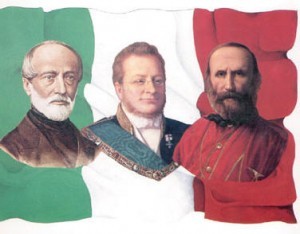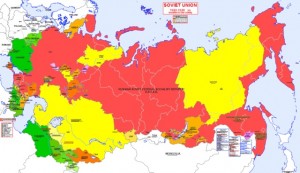Though at first Stalin and the Central Committee argued that it was necessary to collectivize and mobilized the 25,000ers in order to promote controlled collectivization in the countryside, collectivization in rural areas often became controlled by local government organs. The 25,000ers themselves were not influential in these regions because these “rural offices” outnumbered them. ((Lynne Viola, “Collectivization as a Revolution,” in The Stalin Revolution: Foundation of the Totalitarian Era, ed. Robert V. Daniels (Boston: Houghton Mifflin Company,1997), 126.)) Further, when members of the 25,000 attempted to provide feedback to the Central Committee’s Department of Agitation and Mass Campaigns regarding unclear government policies on the gathering of seeds for sowing , they were often rejected from the party. The Central Committee’s inability to accept all feedback from the 25,000ers made the task of controlling collectivization from the top down more difficult.
Despite Stalin’s initial argument that “it was necessary to begin gradually to organize agriculture on the basis of large-scale collective farming,” regional organizations took initiative and began to collectivize at a rapid rate between the years of 1929 and 1930. ((Lynne Viola, “Collectivization as a Revolution,” in The Stalin Revolution: Foundation of the Totalitarian Era, ed. Robert V. Daniels (Boston: Houghton Mifflin Company,1997), 110-112.)) As a result, Stalin and the central government found themselves attempting to control collectivization in response to this rapid growth. In January of 1930, the Central Committee released the decree “On the Tempos of Collectivization and Measures of State Aid to Collective Farm Construction” in order to discourage the forming of rural parties who took it upon themselves to control their region’s collectivization process. Further, the decree encouraged the elimination of the Russian kulaks “as a race.” ((Lynne Viola, “Collectivization as a Revolution,” in The Stalin Revolution: Foundation of the Totalitarian Era, ed. Robert V. Daniels (Boston: Houghton Mifflin Company,1997), 114.)) This decree was an empty threat to rural communities because the members of the 25,000ers who were in each region were not only outnumbered, but considered as outsiders. Though some 25,000ers went against policy and resorted to violence to control these communities, the majority had little authority over the communities and the local government organs. ((Lynne Viola, “Collectivization as a Revolution,” in The Stalin Revolution: Foundation of the Totalitarian Era, ed. Robert V. Daniels (Boston: Houghton Mifflin Company,1997), 122.)) In addition, the encouragement of the elimination of the kulak “race” led to uncontrollable violence in the countryside. In the government’s attempt to regain central control, its policies perpetuated more instability in the rural regions of the USSR.
The 25,000ers did not allow this lack of control to go unnoticed, they frequently reported back to the central government. Members of the 25,000 noted the threat that the kulaks presented, lack of “support offered by villagers,” and the problem of collecting seeds for sowing. ((Lynne Viola, “Collectivization as a Revolution,” in The Stalin Revolution: Foundation of the Totalitarian Era, ed. Robert V. Daniels (Boston: Houghton Mifflin Company,1997), 118-120.)) Regarding the later concern, workers who complained about the government’s lack of specific instructions on the collection of seeds were “transferred, fired, or expelled from the party.” ((Lynne Viola, “Collectivization as a Revolution,” in The Stalin Revolution: Foundation of the Totalitarian Era, ed. Robert V. Daniels (Boston: Houghton Mifflin Company,1997), 119.)) Though these members were trying to point out to the government its own inefficiency and ambiguity, the government rejected this constructive criticism. These reports were clear indicators of many issues present in the countryside, and the government often chose to ignore these critiques. As collectivization continued to increase, the government found itself having difficulty keeping up with this rapid, uncontrollable growth because of its inability to make full use of its reach through the 25,000ers.



